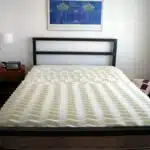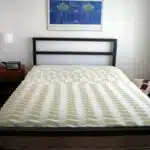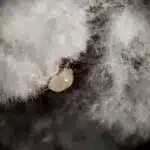Dust mites are microscopic arachnids that live in house dust. They can be found in every home, and they thrive in warm and humid environments such as bedding, carpets, and mattresses. Dust mites feed on dead skin cells shed by humans and pets, causing allergic reactions in some people. In this article, we will discuss how to get rid of dust mites in a mattress.
As a pest control expert, I have encountered many cases of dust mite infestations in mattresses. It is important to note that dust mites are not harmful to humans but can cause discomfort for those who suffer from allergies or asthma. If you suspect that your mattress is infested with dust mites, there are several steps you can take to eliminate them and prevent their return. By following the tips outlined in this article, you can ensure that your mattress is free of these tiny pests and improve the quality of your sleep.
Identifying The Signs Of Dust Mite Infestation
An infestation of dust mites in a mattress can be a truly daunting experience. The thought of sharing your bed with these tiny creatures that feed on dead skin cells and thrive in warm and humid environments is enough to make anyone feel uneasy. Identifying symptoms of dust mite infestation is the first step towards addressing the problem.
The most common sign of dust mite infestation is respiratory symptoms such as coughing, sneezing, and difficulty breathing. These symptoms are typically worse when you wake up in the morning or during the night when you’re lying down on your mattress. Other signs to look out for include skin irritations such as rashes, itching, and redness as well as eye irritation.
Prevention measures are key in keeping dust mites at bay. Keeping your bedroom clean and free from clutter can go a long way in preventing their infestation. Regularly washing bed linens, pillowcases, and duvet covers in hot water (above 130°F) can also help kill any existing dust mites. Investing in allergen-proof mattress covers can also help prevent further infestations by creating a barrier between you and the dust mites that may be living within your mattress.
Understanding Dust Mite Behavior
Dust mites are tiny creatures that thrive in warm and humid environments. They feed on the dead skin cells shed by humans and animals, making the mattress an ideal habitat for their growth. Understanding dust mite behavior is essential to prevent infestations and ensure a healthy living environment.
Dust mites reproduce rapidly, laying up to 80 eggs at a time. Their life cycle lasts around 65-100 days, during which they molt several times, shedding their skin and leaving behind allergenic particles. These particles can cause respiratory problems in individuals with allergies or asthma. Therefore, it is important to take preventive measures to avoid dust mite infestations.
Dust mite prevention techniques include regular cleaning of mattresses and bedding, maintaining low humidity levels in the home, and using allergen-proof covers on pillows and mattresses. By implementing these measures, you can reduce the risk of dust mite infestations and protect your family’s health from potential allergic reactions caused by these microscopic pests.
Regular mattress cleaning is crucial in preventing dust mite infestations and promoting a healthy sleeping environment. It not only removes dust mites but also eliminates other harmful microorganisms that may be present in the mattress. In the subsequent section, we will discuss the importance of regular mattress cleaning in more detail.
The Importance Of Regular Mattress Cleaning
- Regular mattress cleaning is a highly recommended practice for both health and longevity benefits.
- It is important to remove dust mites and other allergens from mattresses to reduce health risks including respiratory problems.
- Regular cleaning can extend the life of the mattress by removing dirt, oils, and sweat that can cause fabric damage and reduce comfort.
- Dust mites are a common allergen found in mattresses, and they are most effectively removed through regular, proper cleaning.
- To reduce dust mites, mattresses should be vacuumed regularly, preferably with a vacuum that has a HEPA filter.
- Mattresses should also be treated with a special mattress cleaning product in order to completely remove dust mites and other allergens.
Health Benefits
Dust mites are microscopic creatures that thrive in warm and moist environments, such as your bed. They feed on dead skin cells and can cause a number of health problems for you and your family. Regular mattress cleaning is important to prevent the growth of dust mites, which can lead to various health benefits.
One of the benefits of regular mattress cleaning is the prevention of allergies and asthma. Dust mites produce allergens that can trigger allergic reactions in sensitive individuals. These reactions can range from mild symptoms like sneezing and coughing to more severe ones like difficulty breathing and chest tightness. Regular cleaning of your mattress can significantly reduce the number of dust mites present, thus reducing the risk of allergic reactions.
Another benefit of regular mattress cleaning is improved sleep quality. Dust mites not only cause allergies but also disrupt your sleep by causing itching and irritation. Regular cleaning removes these irritants, allowing you to get a good night’s rest. Moreover, clean mattresses have been shown to improve overall comfort levels, which can further enhance your sleeping experience.
In conclusion, regular mattress cleaning offers numerous benefits such as prevention of allergies and asthma as well as improved sleep quality. To achieve these benefits, it is recommended that you clean your mattress at least twice a year or more frequently if you have pets or suffer from allergies. By taking preventive measures against dust mites, you and your loved ones can enjoy a healthier and more comfortable sleeping environment.
Prolong Mattress Life
Proper maintenance and regular cleaning of your mattress can not only prevent the growth of dust mites but also prolong the life of your mattress. Mattress maintenance is essential to ensure that it remains in good condition, providing you with a comfortable sleeping experience for years to come.
Dust mites are known to accumulate on mattresses, feeding off dead skin cells and other debris, which can cause wear and tear over time. Regular cleaning can help to remove these particles, preventing them from building up and causing damage to the mattress. By keeping your mattress clean, you can avoid the need for costly repairs or replacements in the future.
In addition to preventing damage, regular mattress cleaning also helps to maintain its shape and support. Over time, mattresses tend to lose their firmness due to prolonged use. However, by regularly removing dirt and debris buildup through cleaning, you can avoid premature sagging or flattening of your mattress. Therefore, proper dust mite prevention measures such as regular cleaning are essential in ensuring the longevity of your mattress.
Reducing Dust Mites
As a pest control expert, it is important to understand the significance of proper mattress maintenance. One of the primary concerns when it comes to mattress cleaning is reducing dust mites. These tiny organisms thrive in warm and humid environments, making your mattress an ideal breeding ground for them. Dust mite allergies are a common problem, causing symptoms such as sneezing, runny nose, wheezing, and even asthma attacks in some individuals. Therefore, reducing these pests is crucial for ensuring a healthy sleeping environment.
One effective way of reducing dust mites is by using mattress covers. These covers act as a barrier between you and the dust mites, preventing them from infesting your beddings and causing allergies. Mattress covers are made from materials that are impermeable to dust mites while still allowing air to circulate through the mattress. It is recommended to use covers that are specifically designed for people with allergies or asthma as they have been tested and proven to be effective in preventing dust mite infestations.
Regular vacuuming and washing of your bedding can also help in reducing dust mites. Vacuuming your mattress every two weeks can remove dead skin cells and other debris that accumulate on its surface, which serves as food for these pests. Washing your bedding at high temperatures can kill any remaining dust mites that may have survived the vacuuming process. By incorporating these practices into your cleaning routine, you can significantly reduce the number of dust mites present in your beddings, improving the overall quality of your sleep and health.
Vacuuming Strategies For Dust Mite Removal
Regular mattress cleaning is an essential part of maintaining good hygiene and overall health. Dust mites are microscopic creatures that thrive in warm, humid environments. They feed on dead skin cells shed by humans and pets, and their waste can cause allergic reactions in sensitive individuals. The accumulation of dust mites in a mattress can lead to respiratory problems, skin irritation, and other health issues.
One effective way to get rid of dust mites in a mattress is by using UV light. UV-C light has been shown to kill dust mites and other microorganisms on contact. It works by damaging the DNA of these organisms, rendering them unable to reproduce or function properly. UV-C lamps can be used to disinfect mattresses, pillows, and other bedding items. However, it is important to note that UV-C light can be harmful to humans if not used properly. Protective eyewear should be worn when using these lamps, and they should not be pointed directly at the skin.
Another method for maintaining mattress hygiene is steam cleaning. This process involves using hot water vapor to penetrate deep into the fibers of the mattress, killing dust mites and bacteria. Steam cleaning also removes stains and odors from the mattress without the use of harsh chemicals. However, it is important to ensure that the mattress dries completely after steam cleaning to prevent mold growth.
Using high heat is another effective way to kill dust mites in a mattress. Most household dryers have a high-heat setting that can be used for this purpose. Simply place bedding items such as sheets, pillowcases, and comforters in the dryer on high heat for at least 30 minutes to kill any dust mites present. However, it is important to check manufacturer’s instructions before subjecting your bedding items to high heat as some materials may shrink or become damaged under high temperatures.
Transition: While using UV light and steam cleaning are excellent methods for removing dust mites from your mattress, using high heat is another effective way to kill these tiny creatures. Let’s take a closer look at how high heat can be used to eliminate dust mites in the next section.
Using High Heat To Kill Dust Mites
High Heat is an effective way to kill dust mites in a mattress. The benefits of using high heat are that it eliminates not only dust mites but also their eggs, which can survive at low temperatures. High heat also does not require the use of harmful chemicals that may affect the quality of air in your home.
To use high heat, place your mattress in direct sunlight on a hot day or use a steam cleaner. Steam cleaning is the most effective method as it raises the temperature of your mattress beyond what is necessary to kill dust mites and their eggs. However, be cautious when using high heat as too much exposure can cause damage to your mattress or even start a fire.
Precautions for using high heat include ensuring that your mattress is dry before exposing it to sunlight or steam cleaning. Moisture attracts dust mites and other allergens, so make sure to let your mattress air out before using high heat methods. Also, be sure to read and follow any safety instructions provided with your steam cleaner. Always wear protective gear such as gloves and goggles when handling hot surfaces.
In conclusion, High Heat is an effective method for eliminating dust mites from your mattress without the need for harmful chemicals. However, it’s important to take precautions when using this method to ensure safety and effectiveness. Next, we will explore freezing techniques to eliminate dust mites from your mattress.
Freezing Techniques To Eliminate Dust Mites
It’s said that the enemy of my enemy is my friend, and when it comes to getting rid of dust mites in a mattress, this couldn’t be truer. One effective ally in the fight against these pesky critters is your home freezer. Freezing has been proven to kill dust mites effectively, making it a popular technique for those looking for an easy solution.
One of the benefits of freezing is that it doesn’t require any chemicals or pesticides, which makes it a safe option for those with allergies or sensitivities. It’s also relatively easy to do; simply remove all bedding from the mattress and place it in a plastic bag. Then, put the bag in the freezer for at least 24 hours. The low temperature will kill off any dust mites and their eggs.
As with any pest control technique, there are safety precautions to keep in mind during freezing. Make sure to seal the plastic bag tightly before putting it in the freezer to prevent moisture from getting inside. Moisture can lead to mold growth, which can exacerbate allergy symptoms. Additionally, if you’re using your kitchen freezer for this task, be sure to clean it thoroughly before and after use to avoid cross-contamination with food.
Freezing is just one step towards eliminating dust mites from your mattress. In the next section, we’ll explore another technique: washing bedding and linens to reduce dust mites. By combining different methods, you can create an effective plan of attack against these tiny invaders and enjoy a more restful night’s sleep as a result.
Washing Bedding And Linens To Reduce Dust Mites
When it comes to reducing dust mites in bedding, washing your sheets and linens is an important step. But what’s the best method for doing so? Hot water or cold water? The answer is hot water. Dust mites are killed at temperatures above 130°F, so washing your bedding in hot water can help eliminate them. Cold water may not be effective at killing dust mites, but it can still remove dirt and debris that may attract them.
In addition to using hot water, you should also wash your bedding regularly to keep dust mites under control. How often you wash your sheets will depend on a few factors: if you have allergies or asthma, if you sweat heavily at night, or if you have pets that sleep on the bed with you. As a general rule of thumb, washing your bedding weekly is recommended to reduce dust mites.
Many people believe that fabric softeners and dryer sheets can help reduce dust mites in bedding, but this is actually a myth. In fact, these products can make the problem worse by leaving behind a residue that attracts dust mites. Instead of using fabric softeners and dryer sheets, consider using white vinegar as a natural alternative. Adding half a cup of white vinegar to the rinse cycle can help remove any leftover detergent residue and leave your bedding feeling soft and fresh.
Transition: Now that we’ve covered how to wash your bedding effectively to reduce dust mites, let’s move on to another important step in protecting yourself from these pesky critters—using encasements on your mattress.
Using Encasements To Protect Your Mattress
When it comes to eliminating dust mites from your mattress, one of the most effective methods is by using a mattress encasement. These encasements are specially designed covers that completely surround your mattress, preventing dust mites from entering or escaping. By keeping the dust mites trapped within the encasement, you can effectively reduce their population and prevent them from causing allergies.
When buying a mattress encasement, there are a few things to keep in mind. Firstly, ensure that it is made of high-quality materials and has a tight weave to prevent any dust mites from getting through. Secondly, look for encasements that have been treated with anti-allergenic compounds such as micro-porous fabric or polyurethane membrane. Lastly, choose an encasement that is easy to clean and maintain.
The benefits of using a mattress encasement go beyond just eliminating dust mites. They also help protect your mattress from spills, stains, and general wear and tear. Additionally, they can extend the life of your mattress by preventing damage caused by bed bugs and other pests. Overall, investing in a good quality mattress encasement is an excellent way to improve your sleep quality and protect your health.
By using a high-quality mattress encasement, you can effectively eliminate dust mites from your sleeping space while also protecting your investment. However, it’s important to remember that simply using an encasement alone may not be enough to completely get rid of all dust mites in your home. In the subsequent section about avoiding humidity and moisture buildup we will discuss additional steps you can take to ensure a clean and healthy living environment free from pests like dust mites.
Avoiding Humidity And Moisture Buildup
Humidity and moisture buildup in a mattress can create the perfect breeding ground for dust mites. To avoid this, it is important to keep your sleeping environment as dry as possible. One way to do this is by using a dehumidifier in your bedroom. Dehumidifiers work by removing excess moisture from the air, which can help prevent dust mites from thriving.
Another effective method for preventing moisture buildup in your mattress is by using a mattress cover. Mattress covers act as a barrier between you and your bed, helping to protect against dust mites and other allergens. They are also waterproof, which means that they can prevent sweat and other bodily fluids from seeping into your mattress and creating a damp environment.
To further reduce humidity levels in your bedroom, make sure that you keep windows and doors open whenever possible to increase ventilation. Additionally, try not to hang wet clothes or towels inside your room, as the moisture can contribute to increased humidity levels.
Incorporating these practices into your daily routine can go a long way towards reducing the risk of dust mite infestations in your bedding. In the next section, we will discuss how choosing hypoallergenic bedding and mattresses can further help alleviate allergy symptoms and improve overall sleep quality.
Choosing Hypoallergenic Bedding And Mattresses
As we mentioned in the previous section, avoiding humidity and moisture buildup is crucial to prevent dust mites from thriving in your mattress. However, it’s equally important to choose hypoallergenic bedding and mattresses to keep these pests at bay. Hypoallergenic products are specially designed to reduce allergens and irritants that can cause allergic reactions and trigger asthma symptoms.
Benefits of hypoallergenic bedding go beyond preventing dust mites. These products typically use natural and organic materials that are free from harsh chemicals and toxins, making them a safer option for people with sensitive skin or respiratory issues. Moreover, hypoallergenic bedding can also provide better temperature control, breathability, and moisture-wicking properties, leading to a more comfortable sleep experience.
When it comes to selecting a mattress brand for allergy sufferers, there are several options available in the market. Some popular brands include Casper Wave Hybrid, Saatva Classic Mattress, and Avocado Green Mattress. These mattresses use high-quality materials that resist mold, bacteria growth, dust mites infestation while offering exceptional support and comfort. It’s worth noting that investing in a good quality mattress not only helps you sleep better but also reduces the risk of developing long-term health problems associated with poor sleep quality.
Transition into next section: While choosing the right bedding and mattress can help keep dust mites at bay, using essential oils is another effective way to repel these pesky critters naturally without resorting to harsh chemicals or pesticides.
Using Essential Oils To Repel Dust Mites
Incorporating essential oils into your cleaning routine is an effective way to repel dust mites in your mattress. Essential oils are potent plant extracts that contain unique properties, such as antibacterial and antifungal that can help eliminate harmful microbes in your sleeping area. You can either purchase essential oil blends from health stores or make DIY solutions at home using readily available ingredients.
Here are four essential oil blends that can help repel dust mites in your mattress:
Tea tree and eucalyptus: These essential oils possess antibacterial and antifungal properties that can help eliminate dust mites from your mattress.
Lavender: This essential oil has a calming effect on the body, which can improve sleep quality while repelling dust mites.
Lemon: The acidic nature of lemon makes it an effective natural disinfectant that can help kill germs and repel dust mites.
Peppermint: Peppermint is a natural insect repellent that can be used to repel dust mites from your sleeping area.
To use these essential oils, you can add a few drops to a spray bottle filled with water and mist over your mattress regularly. Alternatively, you can mix them with baking soda to create a powder mixture to sprinkle over the mattress before vacuuming.
Using essential oils is an affordable and natural way to repel dust mites from your mattress. However, if you have severe allergies or asthma, professional mattress cleaning services may be necessary for deep cleaning and removal of allergens.
Professional Mattress Cleaning Services
Hiring professional mattress cleaners can provide numerous benefits in terms of maintaining cleanliness and hygiene in your home. Not only do they have the proper tools and equipment to remove dust mites, but they also use environmentally friendly solutions that are safe for you and your family.
One of the key benefits of hiring professional mattress cleaning services is their expert knowledge on how to remove dust mites from mattresses. They have specialized techniques that can penetrate deep into the fibers of the mattress, effectively removing all traces of dust mites and other allergens. Additionally, professional cleaners can help extend the life of your mattress by removing any stains or odors, leaving it fresh and clean.
When choosing a mattress cleaning service provider, it’s important to consider their experience and reputation in the industry. Look for companies that have been in business for a long time and have positive reviews from previous customers. Also, make sure they are licensed and insured, so you can be confident that you’re getting high-quality service.
Transitioning into the subsequent section about maintaining cleanliness and hygiene in your home, it’s important to note that regular cleaning and upkeep is essential for preventing dust mites from accumulating in your mattress. In addition to hiring professional cleaners, make sure to vacuum your mattress regularly, wash bedding in hot water at least once a week, and keep pets off the bed. By taking these steps, you can help ensure a healthy sleeping environment for you and your loved ones.
Maintaining Cleanliness And Hygiene In Your Home
- Cleaning surfaces is an important part of maintaining cleanliness and hygiene in the home. Regularly disinfecting surfaces with an appropriate cleaner will help reduce the spread of bacteria and other contaminants.
- Laundry hygiene is also important to maintain cleanliness in the home. Regularly washing bedding, towels and other fabrics in hot water will help kill dust mites and other allergens.
- Vacuuming carpets is another way to help reduce dust mites and other allergens. Vacuuming regularly with a good quality vacuum cleaner will help remove dirt and debris from carpets and other fabrics.
- Vacuuming mattresses can also help reduce dust mites. To do this, focus on cleaning the seams and crevices of the mattress with a high suction vacuum cleaner.
- To further reduce the dust mites in a mattress, an encasement can be used. The encasement should be made of a tightly woven, hypoallergenic fabric to ensure the dust mites are not able to pass through.
- Finally, it is important to keep the mattress dry. Moisture can encourage the growth of dust mites, so avoiding spills and regularly airing the mattress is important.
Cleaning Surfaces
As a pest control expert, we understand the importance of maintaining cleanliness and hygiene in your home. One of the most common problems that people face is the presence of dust mites in their mattresses. These tiny creatures feed on dead skin cells and can cause allergies and respiratory problems if not eliminated. To get rid of them, steam cleaning is an effective method as it kills both mites and their eggs.
All-natural solutions are also available for those who prefer a chemical-free option. Baking soda is an excellent choice as it absorbs moisture and deodorizes the mattress. Simply sprinkle baking soda over the surface, leave it for at least 30 minutes, then vacuum thoroughly to remove any residue. Another option is using tea tree oil, which has antimicrobial properties that can help eliminate dust mites. Mix a few drops with water in a spray bottle and mist over the mattress before allowing it to air dry.
It’s crucial to remember that maintaining cleanliness goes beyond just cleaning visible surfaces; it includes paying attention to hidden areas like mattresses too. By utilizing these methods such as steam cleaning or all-natural solutions like baking soda or tea tree oil, you can effectively get rid of dust mites in your mattress and improve your overall health and hygiene at home.
Laundry Hygiene
Maintaining cleanliness and hygiene in your home is crucial to prevent the spread of disease-carrying pests. While people may focus on visible surfaces, it’s essential to pay attention to hidden areas like laundry too. Laundry hygiene plays a significant role in keeping your home clean and safe.
The best detergents for laundry are those that can effectively remove stains and kill bacteria. Look for products that contain bleach or enzymes, which can help break down tough stains and sanitize fabrics. It’s also important to use the right amount of detergent as overuse can leave residue on clothes that attract pests.
Effective drying techniques are also key to maintaining laundry hygiene. Avoid overcrowding the dryer as this can prevent proper airflow and lead to damp clothes that attract pests. Use the highest heat setting possible when drying, especially for items like towels or bedding, as this will kill any remaining bacteria or pests. Additionally, make sure to clean out your dryer vent regularly to prevent lint buildup, which can cause fires and attract pests.
By following these simple steps for laundry hygiene, you can keep your home clean and pest-free. Remember that a healthy home starts with regular cleaning habits, so make sure to incorporate these tips into your routine for optimal results.
Vacuuming Carpets
Maintaining cleanliness and hygiene in your home is not only important for the comfort of your family but also for preventing the spread of pests and diseases. One area that should not be overlooked is carpet maintenance. Carpets can harbor a wide range of pests, including dust mites, fleas, and bed bugs. Vacuuming regularly is an essential part of keeping your carpets clean and pest-free.
Effective vacuuming techniques include using a vacuum with a HEPA filter to capture small particles like dust mites and pet dander. It’s also important to vacuum slowly and in different directions to ensure you are picking up as much debris as possible. Pay extra attention to high-traffic areas like hallways, entryways, and living rooms, as these areas are more likely to have trapped dirt and debris.
In addition to regular vacuuming, it’s also important to schedule professional carpet cleaning services at least once a year. Professional cleaners use specialized equipment that can remove deep-seated stains and dirt that may not be visible on the surface. By following these tips for carpet maintenance, you can keep your home clean and pest-free while also maintaining the longevity of your carpets.
Tips For Allergy And Asthma Sufferers
For allergy and asthma sufferers, dealing with symptoms can be a challenging task. Dust mites are one of the common triggers for these conditions, and they thrive in warm and humid environments such as mattresses. While eliminating dust mites entirely is impossible, practical prevention methods can help reduce their population and minimize symptoms.
One effective method to control dust mites is to encase your mattress, pillows, and bedding in allergen-proof covers. These covers act as a barrier that prevents dust mites from penetrating the surface of your bedding. Additionally, it’s recommended to wash your bedding regularly in hot water above 130°F to kill any remaining mites.
Another practical method is to reduce humidity levels within your home. Dust mites thrive in humid environments; therefore, using dehumidifiers or air conditioners can help keep the air dry and reduce the growth of these pests. Moreover, vacuuming frequently with a HEPA filter-equipped vacuum cleaner can remove dust and debris that attract dust mites.
To prevent future dust mite infestations, it’s crucial to maintain cleanliness within your home regularly. Cleaning surfaces such as floors and furniture can help eliminate dead skin cells that attract dust mites. Additionally, washing soft toys or keeping them inside a plastic bag can prevent them from becoming breeding grounds for these pests. By incorporating these practical prevention methods into your routine, you can minimize the risk of developing allergies or asthma symptoms caused by dust mites.
Preventing Future Dust Mite Infestations
For allergy and asthma sufferers, keeping dust mites at bay is a top priority. One of the most common places where these pests reside is in your mattress. Fortunately, there are ways to get rid of them and prevent future infestations. In this section, we will discuss some effective methods for eliminating dust mites in your mattress.
Firstly, consider using mattress encasements to protect your bed from dust mites. These covers are specifically designed to keep these tiny pests out by creating an impenetrable barrier around your mattress. They are made of special materials that are resistant to dust mites and other allergens, making them an effective long-term solution for keeping your bed clean and safe.
Another way to get rid of dust mites in your mattress is through humidity control. Dust mites thrive in warm and humid environments, so reducing the humidity levels in your bedroom can help significantly reduce their numbers. You can use a dehumidifier or air conditioner to lower the humidity levels in your room and make it less hospitable for these pests.
To further help you combat dust mites in your mattress, here are four quick tips:
- Regularly wash all bedding including sheets, pillowcases and comforters.
- Vacuum the surface of the mattress at least once a week.
- Avoid sleeping with pets as they can also carry allergens like dander which attract dust mites.
- Replace old pillows every two years.
Overall, preventing future infestations requires diligence on your part. By implementing these strategies such as using mattress encasements and controlling humidity levels, you can drastically reduce the number of dust mites living in your bed while simultaneously improving the quality of life for allergy and asthma sufferers alike.
Conclusion
Dust mites are a common problem that can cause allergies and asthma. Identifying the signs of infestation is important in order to take necessary steps to get rid of them. Understanding dust mite behavior can help you effectively remove them from your mattress.
Regular mattress cleaning is crucial in preventing dust mite infestations. Vacuuming strategies and using high heat can also aid in removing these pests. Professional mattress cleaning services can be sought for more thorough cleaning.
Maintaining cleanliness and hygiene in your home is the key to preventing future dust mite infestations. Tips for allergy and asthma sufferers include using air purifiers, washing bedding frequently, and keeping humidity levels low.
In conclusion, as a pest control expert, it is important to understand that dealing with dust mites requires a multi-faceted approach that involves regular maintenance and cleaning. By following these steps, you can ensure that your home remains free of these unwanted pests. Remember: prevention is always better than cure, so take proactive measures to keep your living space clean and hygienic. Let’s make our homes a safe haven from these pesky critters!
Image Credits
- “House dust mites” by Gilles San Martin (featured)



















![How To Keep Sheets On A Bed: 10 Strategies 19 Bed sheets [Explored 2013-04-27]](https://green-life.blog/wp-content/uploads/2023/04/pH7FwL8jspjq-150x150.jpg.webp)






![Calculating How Much Stone Dust You Need 26 [Blog Post]Stone Dust © Oxfam Australia](https://green-life.blog/wp-content/uploads/2023/05/GdZVzgTqPhjq-150x150.jpg.webp)


